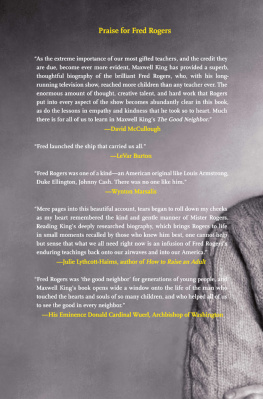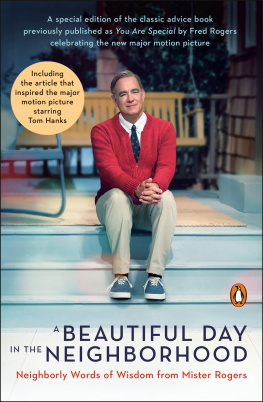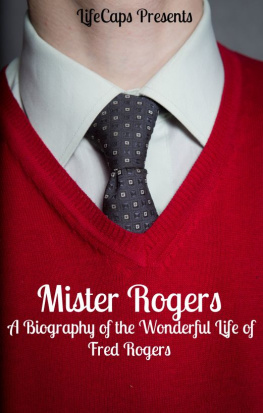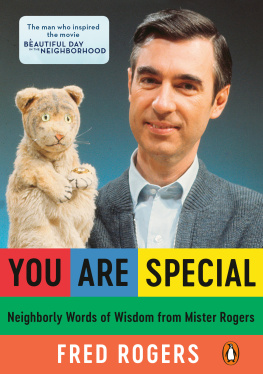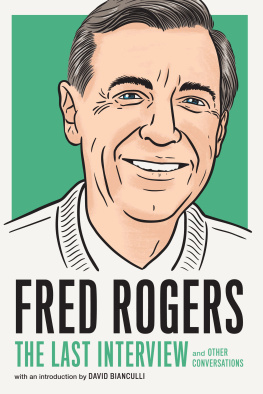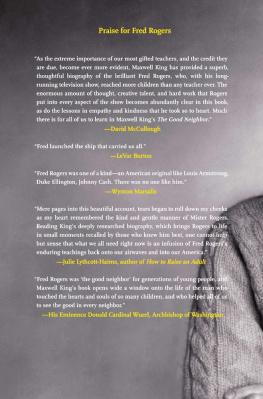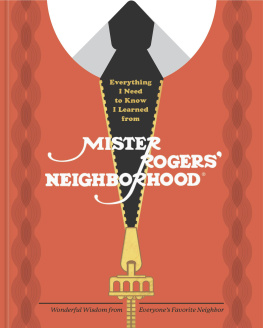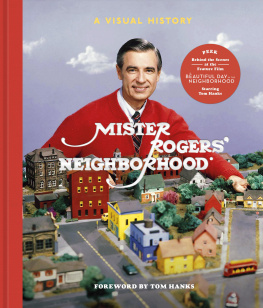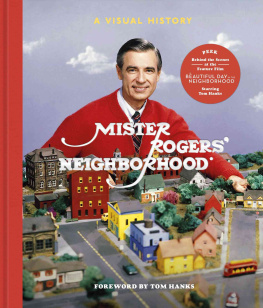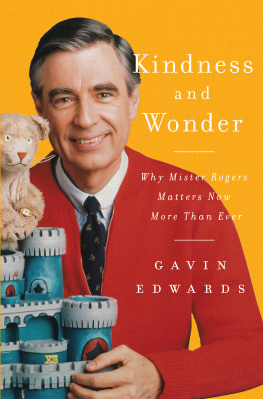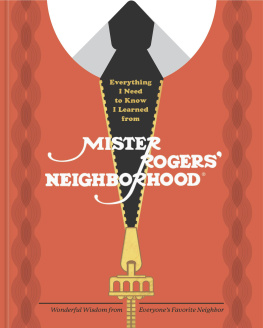
Copyright 2018 Maxwell King
Cover 2018 Abrams
Published in 2018 by Abrams Press, an imprint of ABRAMS. All rights reserved. No portion of this book may be reproduced, stored in a retrieval system, or transmitted in any form or by any means, mechanical, electronic, photocopying, recording, or otherwise, without written permission from the publisher.
Library of Congress Control Number: 2017956802
ISBN: 978-1-4197-2772-6
eISBN: 978-1-68335-349-2
Abrams books are available at special discounts when purchased in quantity for premiums and promotions as well as fundraising or educational use. Special editions can also be created to specification. For details, contact specialsales@abramsbooks.com or the address below.
Abrams Press is a registered trademark of Harry N. Abrams, Inc.

ABRAMS The Art of Books
195 Broadway, New York, NY 10007
abramsbooks.com
PHOTO CREDITS
Insert 1: , bottom: Lynn Johnson. Reproduced with permission of the Fred Rogers Company and Ohio University.
Insert 2: : top, Lynn Johnson, bottom, reproduced with permission of the Fred Rogers Company.
For Margaret Ann King My Polestar
There are three ways to ultimate success:
The first way is to be kind.
The second way is to be kind.
The third way is to be kind.
FRED ROGERS
CONTENTS
PROLOGUE: A BEAUTIFUL DAY
Fred Rogers had given some very specific instructions to David Newell, who handled public relations for the PBS childrens show Mister Rogers Neighborhood. Rogers said he wanted no childrenabsolutely noneto be present when he appeared on The Oprah Winfrey Show in Chicago. No children? How could that be? By the mid-1980s, Rogers was an icon of childrens television, known for communicating with his young viewers in the most fundamental and profound way. Why would he want to exclude them from a program showcasing his views on how they should be understood and taught?
But Fred Rogers knew himself far better than even friends like Newell, who had worked with him for decades. He knew that if there were children in the studio audience, he wouldnt focus on Winfreys questions, he wouldnt pay heed to her legion of viewers, and he wouldnt convey the great importance of his work. The children and their needs would come first. He couldnt help it, never could help it. Decades before, Rogers had programmed himself to focus on the needs of little children, and by now he had reached a point at which he could not fail to respond to a child who asked something of himanything at all.
He asked David Newell (who also played Mr. McFeely, a central character on Rogerss program) to be clear with Winfreys staff: If there are children in the audience, Fred knows hell do a poor job of helping Oprah to make the interview a success. But the message wasnt received. When Rogers came before Winfreys studio audience on a brisk December day in 1985, he found the audience composed almost entirely of families, mainly very young children with their mothers.
Winfreys staff had decided that after she interviewed Rogers, it would be fun to have him take questions from the audience, and maybe provide some guidance to mothers. And he certainly tried, telling them that to understand children, I think the best that we can do is to think about what it was like for us. But the plan didnt succeed. As soon as the children started to ask him questions directly, he seemed to get lost in their world, slowing his responses to their pace, and even hunching in his chair as if to insinuate himself down to their level.
This wasnt good televisionat least, good adult television. Everything was going into a kind of slow motion as Fred Rogers became Mister Rogers, connecting powerfully with the smallest children present. He seemed to forget the camera as he focused on them one by one. Winfrey began to look a little worried. Although she was still about a year away from the national syndication that would make her a superstar, her program was already a big hit. And here she was losing control of it to a bunch of kids, and what looked like a slightly befuddled grandfather.
Then it got worse. In the audience, Winfrey leaned down with her microphone to ask a little blond girl if she had a question for Mister Rogers. Instead of answering, the child broke away from her mother, pushed past Winfrey, and ran down to the stage to hug him. As the only adult present not stunned by this, apparently, Fred Rogers knelt to accept her embrace.
Minutes later, he was kneeling again, this time to allay a small boys concerns about a miniature trolley installed on Winfreys stage to recall the famous one from his own show, the trolley that traveled to the Neighborhood of Make-Believe. The boy was worried about the tracks, which seemed to be canted precariously at the edge of the stage. As the two conferred quietly, Winfrey stood in the audience looking more than a little lost. Seeing that the show was slipping away from her, she signaled her crew to break to an ad.
For Fred Rogers, it was always this way when he was with children, in person or on his hugely influential program. Every weekday, this soft-spoken man talked directly into the camera to address his television neighbors in the audience as he changed from his street clothes into his iconic cardigan and sneakers. Children responded so powerfully, so completely, to Rogers that everything else in their world seemed to fall away as he sang, Its a beautiful day in the neighborhood. Then his preschool-age fans knew that he was fully engaged as Mister Rogers, their adult friend who valued his viewers just the way you are.
It was an offer of unconditional loveand millions took it. Mister Rogers Neighborhood often reached 10 percent of American households, five to ten million children each day who wanted to spend time with this quiet, slightly stooped, middle-aged man with a manner so gentle as to seem a little feminine.
Over time, as new generations of parentssome of whom had grown up with the Neighborhood themselvesswelled the ranks of his admirers, Fred Rogers achieved something almost unheard of in television: He reached a huge nationwide audience with an educational program, a reach he sustained for almost four decades. Rogers became a national advocate for early education just at the time that psychologists, child-development experts, and researchers worldwide were finding that learning that takes place in the earliest yearssocial and emotional, as well as cognitiveis a crucial building block for successful and happy lives.
Mister Rogerss appeal was evident from the beginning of his career, as the managers of WGBH in Boston discovered one day in April 1967. At that point, his program aired on the Eastern Educational Network (a PBS precursor) and was called Misterogers Neighborhood. It had been shown regionally for only a year. Recognizing its popularity, the managers organized a meet-the-host event and broadcast an invitation for Rogerss young viewers to come to the station with their parents. The staff was prepared for a crowd of five hundred people.
Five thousand showed up. The line stretched down the street toward Soldiers Field, where the Harvard football team played, and created traffic slowdowns reminiscent of game days. The station quickly ran out of snacks for the children. As the line wound into the studio, Rogers insisted on kneeling to talk with each child, just as he would on Oprah Winfreys show nearly two decades later. The queue got longer and longer until it stretched past the stadium.
Next page
